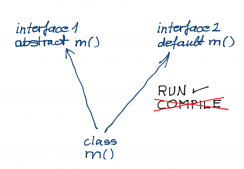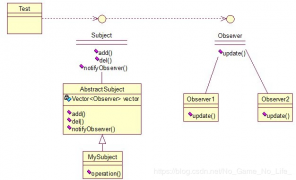Mapper的内置方法
model层就是实体类,对应数据库的表。controller层是Servlet,主要是负责业务模块流程的控制,调用service接口的方法,在struts2就是Action。Service层主要做逻辑判断,Dao层是数据访问层,与数据库进行对接。至于Mapper是mybtis框架的映射用到,mapper映射文件在dao层用。
下面是介绍一下Mapper的内置方法:
1、countByExample ===>根据条件查询数量
|
1
2
3
4
5
6
7
|
int countByExample(UserExample example); //下面是一个完整的案列UserExample example = new UserExample(); Criteria criteria = example.createCriteria(); criteria.andUsernameEqualTo("joe"); int count = userDAO.countByExample(example); |
相当于:select count(*) from user where username='joe'
2、deleteByExample ===>根据条件删除多条
|
1
2
3
4
5
6
7
8
|
int deleteByExample(AccountExample example); //下面是一个完整的案例UserExample example = new UserExample(); Criteria criteria = example.createCriteria(); criteria.andUsernameEqualTo("joe"); userDAO.deleteByExample(example); 相当于:delete from user where username='joe' |
3、deleteByPrimaryKey===>根据条件删除单条
|
1
2
|
int deleteByPrimaryKey(Integer id);userDAO.deleteByPrimaryKey(101); |
相当于:
|
1
2
|
delete from user where id=101 |
4、insert===>插入数据
|
1
2
3
4
5
6
7
8
9
|
int insert(Account record); //下面是完整的案例User user = new User(); //user.setId(101); user.setUsername("test"); user.setPassword("123456") user.setEmail("674531003@qq.com"); userDAO.insert(user); |
相当于:
|
1
|
insert into user(ID,username,password,email) values(101,'test','123456','674531003@qq.com'); |
5、insertSelective===>插入数据
|
1
|
int insertSelective(Account record); |
6、selectByExample===>根据条件查询数据
|
1
2
3
4
5
6
7
8
9
10
11
12
|
List<Account> selectByExample(AccountExample example); //下面是一个完整的案例UserExample example = new UserExample();Criteria criteria = example.createCriteria();criteria.andUsernameEqualTo("joe");criteria.andUsernameIsNull();example.setOrderByClause("username asc,email desc");List<?>list = userDAO.selectByExample(example);相当于:select * from user where username = 'joe' and username is null order by username asc,email desc //注:在iBator 生成的文件UserExample.java中包含一个static 的内部类 Criteria ,在Criteria中有很多方法,主要是定义SQL 语句where后的查询条件。 |
7、selectByPrimaryKey===>根据主键查询数据
|
1
|
Account selectByPrimaryKey(Integer id);//相当于select * from user where id = 变量id |
8、updateByExampleSelective===>按条件更新值不为null的字段
|
1
2
3
4
5
6
7
8
9
10
|
int updateByExampleSelective(@Param("record") Account record, @Param("example") AccountExample example); //下面是一个完整的案列UserExample example = new UserExample(); Criteria criteria = example.createCriteria(); criteria.andUsernameEqualTo("joe"); User user = new User(); user.setPassword("123"); userDAO.updateByPrimaryKeySelective(user,example); 相当于:update user set password='123' where username='joe' |
9、updateByExampleSelective===>按条件更新
|
1
|
int updateByExample(@Param("record") Account record, @Param("example") AccountExample example); |
10、updateByPrimaryKeySelective===>按条件更新
|
1
2
3
4
5
6
7
8
|
int updateByPrimaryKeySelective(Account record);//下面是一个完整的案例 User user = new User();user.setId(101);user.setPassword("joe");userDAO.updateByPrimaryKeySelective(user); |
相当于:
|
1
|
update user set password='joe' where id=101 |
|
1
2
3
4
5
6
7
8
|
int updateByPrimaryKeySelective(Account record); //下面是一个完整的案例 User user = new User();user.setId(101);user.setPassword("joe");userDAO.updateByPrimaryKeySelective(user); |
相当于:update user set password='joe' where id=101
11、updateByPrimaryKey===>按主键更新
|
1
2
3
4
5
6
7
8
9
|
int updateByPrimaryKey(Account record);//下面是一个完整的案例User user =new User(); user.setId(101); user.setUsername("joe"); user.setPassword("joe"); user.setEmail("joe@163.com"); userDAO.updateByPrimaryKey(user); |
相当于:
|
1
|
update user set username='joe',password='joe',email='joe@163.com' where id=101 |
|
1
2
3
4
5
6
7
8
9
|
int updateByPrimaryKey(Account record); //下面是一个完整的案例User user =new User(); user.setId(101); user.setUsername("joe"); user.setPassword("joe"); user.setEmail("joe@163.com"); userDAO.updateByPrimaryKey(user); |
相当于:
|
1
|
update user set username='joe',password='joe',email='joe@163.com' where id=101 |
解析mapper的xml配置文件
我们来看看mybatis是怎么读取mapper的xml配置文件并解析其中的sql语句。
我们还记得是这样配置sqlSessionFactory的:
|
1
2
3
4
5
6
|
<bean id="sqlSessionFactory" class="org.mybatis.spring.SqlSessionFactoryBean"> <property name="dataSource" ref="dataSource" /> <property name="configLocation" value="classpath:configuration.xml"></property> <property name="mapperLocations" value="classpath:com/xxx/mybatis/mapper/*.xml"/> <property name="typeAliasesPackage" value="com.tiantian.mybatis.model" /> </bean> |
这里配置了一个mapperLocations属性,它是一个表达式,sqlSessionFactory会根据这个表达式读取包com.xxx.mybaits.mapper下面的所有xml格式文件,那么具体是怎么根据这个属性来读取配置文件的呢?
答案就在SqlSessionFactoryBean类中的buildSqlSessionFactory方法中:
|
1
2
3
4
5
6
7
8
9
10
11
12
13
14
15
16
17
18
19
20
21
|
if (!isEmpty(this.mapperLocations)) { for (Resource mapperLocation : this.mapperLocations) { if (mapperLocation == null) { continue; } try { XMLMapperBuilder xmlMapperBuilder = new XMLMapperBuilder(mapperLocation.getInputStream(), configuration, mapperLocation.toString(), configuration.getSqlFragments()); xmlMapperBuilder.parse(); } catch (Exception e) { throw new NestedIOException("Failed to parse mapping resource: '" + mapperLocation + "'", e); } finally { ErrorContext.instance().reset(); } if (logger.isDebugEnabled()) { logger.debug("Parsed mapper file: '" + mapperLocation + "'"); } } } |
mybatis使用XMLMapperBuilder类的实例来解析mapper配置文件。
|
1
2
3
4
5
6
7
8
9
10
11
12
|
public XMLMapperBuilder(Reader reader, Configuration configuration, String resource, Map<String, XNode> sqlFragments) { this(new XPathParser(reader, true, configuration.getVariables(), new XMLMapperEntityResolver()), configuration, resource, sqlFragments); } private XMLMapperBuilder(XPathParser parser, Configuration configuration, String resource, Map<String, XNode> sqlFragments) { super(configuration); this.builderAssistant = new MapperBuilderAssistant(configuration, resource); this.parser = parser; this.sqlFragments = sqlFragments; this.resource = resource; } |
接着系统调用xmlMapperBuilder的parse方法解析mapper。
|
1
2
3
4
5
6
7
8
9
10
11
12
13
14
15
16
|
public void parse() { //如果configuration对象还没加载xml配置文件(避免重复加载,实际上是确认是否解析了mapper节点的属性及内容, //为解析它的子节点如cache、sql、select、resultMap、parameterMap等做准备), //则从输入流中解析mapper节点,然后再将resource的状态置为已加载 if (!configuration.isResourceLoaded(resource)) { configurationElement(parser.evalNode("/mapper")); configuration.addLoadedResource(resource); bindMapperForNamespace(); } //解析在configurationElement函数中处理resultMap时其extends属性指向的父对象还没被处理的<resultMap>节点 parsePendingResultMaps(); //解析在configurationElement函数中处理cache-ref时其指向的对象不存在的<cache>节点(如果cache-ref先于其指向的cache节点加载就会出现这种情况) parsePendingChacheRefs(); //同上,如果cache没加载的话处理statement时也会抛出异常 parsePendingStatements(); } |
mybatis解析mapper的xml文件的过程已经很明显了,接下来我们看看它是怎么解析mapper的:
|
1
2
3
4
5
6
7
8
9
10
11
12
13
14
15
16
17
18
19
20
21
22
23
24
25
26
27
|
private void configurationElement(XNode context) { try { //获取mapper节点的namespace属性 String namespace = context.getStringAttribute("namespace"); if (namespace.equals("")) { throw new BuilderException("Mapper's namespace cannot be empty"); } //设置当前namespace builderAssistant.setCurrentNamespace(namespace); //解析mapper的<cache-ref>节点 cacheRefElement(context.evalNode("cache-ref")); //解析mapper的<cache>节点 cacheElement(context.evalNode("cache")); //解析mapper的<parameterMap>节点 parameterMapElement(context.evalNodes("/mapper/parameterMap")); //解析mapper的<resultMap>节点 resultMapElements(context.evalNodes("/mapper/resultMap")); //解析mapper的<sql>节点 sqlElement(context.evalNodes("/mapper/sql")); //使用XMLStatementBuilder的对象解析mapper的<select>、<insert>、<update>、<delete>节点, //mybaits会使用MappedStatement.Builder类build一个MappedStatement对象, //所以mybaits中一个sql对应一个MappedStatement buildStatementFromContext(context.evalNodes("select|insert|update|delete")); } catch (Exception e) { throw new BuilderException("Error parsing Mapper XML. Cause: " + e, e); } } |
configurationElement函数几乎解析了mapper节点下所有子节点,至此mybaits解析了mapper中的所有节点,并将其加入到了Configuration对象中提供给sqlSessionFactory对象随时使用。这里我们需要补充讲一下mybaits是怎么使用XMLStatementBuilder类的对象的parseStatementNode函数借用MapperBuilderAssistant类对象builderAssistant的addMappedStatement解析MappedStatement并将其关联到Configuration类对象的:
|
1
2
3
4
5
6
7
8
9
10
11
12
13
14
15
16
17
18
19
20
21
22
23
24
25
26
27
28
29
30
31
32
33
34
35
36
37
38
39
40
41
42
43
44
45
46
47
48
49
50
51
52
53
54
55
56
57
58
59
60
61
62
63
64
65
66
67
68
69
70
71
72
73
74
75
|
public void parseStatementNode() { //ID属性 String id = context.getStringAttribute("id"); //databaseId属性 String databaseId = context.getStringAttribute("databaseId"); if (!databaseIdMatchesCurrent(id, databaseId, this.requiredDatabaseId)) { return; } //fetchSize属性 Integer fetchSize = context.getIntAttribute("fetchSize"); //timeout属性 Integer timeout = context.getIntAttribute("timeout"); //parameterMap属性 String parameterMap = context.getStringAttribute("parameterMap"); //parameterType属性 String parameterType = context.getStringAttribute("parameterType"); Class<?> parameterTypeClass = resolveClass(parameterType); //resultMap属性 String resultMap = context.getStringAttribute("resultMap"); //resultType属性 String resultType = context.getStringAttribute("resultType"); //lang属性 String lang = context.getStringAttribute("lang"); LanguageDriver langDriver = getLanguageDriver(lang); Class<?> resultTypeClass = resolveClass(resultType); //resultSetType属性 String resultSetType = context.getStringAttribute("resultSetType"); StatementType statementType = StatementType.valueOf(context.getStringAttribute("statementType", StatementType.PREPARED.toString())); ResultSetType resultSetTypeEnum = resolveResultSetType(resultSetType); String nodeName = context.getNode().getNodeName(); SqlCommandType sqlCommandType = SqlCommandType.valueOf(nodeName.toUpperCase(Locale.ENGLISH)); //是否是<select>节点 boolean isSelect = sqlCommandType == SqlCommandType.SELECT; //flushCache属性 boolean flushCache = context.getBooleanAttribute("flushCache", !isSelect); //useCache属性 boolean useCache = context.getBooleanAttribute("useCache", isSelect); //resultOrdered属性 boolean resultOrdered = context.getBooleanAttribute("resultOrdered", false); // Include Fragments before parsing XMLIncludeTransformer includeParser = new XMLIncludeTransformer(configuration, builderAssistant); includeParser.applyIncludes(context.getNode()); // Parse selectKey after includes and remove them. processSelectKeyNodes(id, parameterTypeClass, langDriver); // Parse the SQL (pre: <selectKey> and <include> were parsed and removed) SqlSource sqlSource = langDriver.createSqlSource(configuration, context, parameterTypeClass); //resultSets属性 String resultSets = context.getStringAttribute("resultSets"); //keyProperty属性 String keyProperty = context.getStringAttribute("keyProperty"); //keyColumn属性 String keyColumn = context.getStringAttribute("keyColumn"); KeyGenerator keyGenerator; String keyStatementId = id + SelectKeyGenerator.SELECT_KEY_SUFFIX; keyStatementId = builderAssistant.applyCurrentNamespace(keyStatementId, true); if (configuration.hasKeyGenerator(keyStatementId)) { keyGenerator = configuration.getKeyGenerator(keyStatementId); } else { //useGeneratedKeys属性 keyGenerator = context.getBooleanAttribute("useGeneratedKeys", configuration.isUseGeneratedKeys() && SqlCommandType.INSERT.equals(sqlCommandType)) ? new Jdbc3KeyGenerator() : new NoKeyGenerator(); } builderAssistant.addMappedStatement(id, sqlSource, statementType, sqlCommandType, fetchSize, timeout, parameterMap, parameterTypeClass, resultMap, resultTypeClass, resultSetTypeEnum, flushCache, useCache, resultOrdered, keyGenerator, keyProperty, keyColumn, databaseId, langDriver, resultSets); } |
由以上代码可以看出mybaits使用XPath解析mapper的配置文件后将其中的resultMap、parameterMap、cache、statement等节点使用关联的builder创建并将得到的对象关联到configuration对象中,而这个configuration对象可以从sqlSession中获取的,这就解释了我们在使用sqlSession对数据库进行操作时mybaits怎么获取到mapper并执行其中的sql语句的问题。















